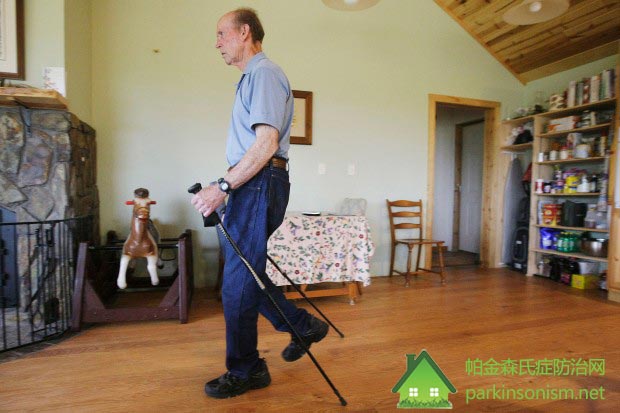当前页面: 帕金森 Parkinsonism 论坛 » 帕金森 parkinsonism 预防与控制 » [原创翻译] 运动有助于缓解帕金森氏症状
[原创翻译] 运动有助于缓解帕金森氏症状
[第1楼 PID6958] 2011-08-29 16:27 GoldenPig 写道:
[原创翻译] 运动有助于缓解帕金森氏症状
帕金森病导致的颤抖会减缓人的运动机能,甚至变为彻底的失去运动功能。而通过运动疗法,有助于帮助帕金森病人缓解症状,恢复运动机能。我之前翻译过多篇有关帕金森运动疗法的文章,上个月病友 Pinger 亦分享了他使用柔力球以及唱歌进行运行疗法的经历。最近 Rapidcityjournal 一篇新闻报道,也讲述了一名叫范福科的帕金森病人,通过参加大脑康复锻炼,身体动作变得灵活了,步态平稳了,并且增加了他对战胜疾病的信心。地址: http://www.parkinsonism.net/prevent/ease-parkinson.htm
[第2楼 PID6958] 2012-08-20 19:27 Robot :
[原创翻译] 运动有助于缓解帕金森氏症状 相关
[第3楼 PID6959] 2011-08-29 16:28 GoldenPig 写道:
回复: [原创翻译] 运动有助于缓解帕金森氏症状

配图: 运动有助于缓解帕金森氏症状。范福科现在每天在用拐杖的辅助下行走30分钟,这样可以调整他背部的肌肉
[第4楼 PID6960] 2011-08-29 16:32 GoldenPig 写道:
回复: [原创翻译] 运动有助于缓解帕金森氏症状
范福科的相片:
[第5楼 PID6961] 2011-08-29 16:34 GoldenPig 写道:
回复: [原创翻译] 运动有助于缓解帕金森氏症状
原文:以下是被引用的内容:
It started, like it so often does, with a small tremor in his right hand.
“It was gradual, and it came and went,” said Bill Van Heukelem of Rockerville.
The tremors made it hard to do simple things, including brushing his teeth.
Doctors gave the official diagnosis — Parkinson’s disease — nine years ago, when Van Heukelem was 60 years old. He wasn’t particularly surprised by the diagnosis.
“My mother had Parkinson’s, so I started to suspect it,” Van Heukelem said.
A progressive neurological disorder of the nervous system, Parkinson’s affects movement. About 500,000 Americans have been diagnosed with it. The disease causes tremors as well as slowing or freezing of movement.
A marine biologist living in Maryland at the time of his diagnosis, Van Heukelem faced the usual progression of symptoms, from tremors to rigid muscles. By 2004, he lost the ability to write.
In 2007, Van Heukelem and his wife, Laurie, moved to the Black Hills to be close to their daughter, Lynne Loverich, a physical therapist at Custer Regional Medical Center.
Van Heukelem’s symptoms continued to progress. He began to drag his right foot. His face became more mask-like, unable to show elaborate emotion.
Other than oral medication, Van Heukelem was given few tools to manage the disease and admits it was hard to keep a positive attitude, especially when he remembered his own mother being bedridden from the disease.
“Having to watch my mother go through it,” he said, “I knew what was coming.”
Then, earlier this year, the Van Heukelems heard about a program called Exercise4BrainChange through the NeuroFitNetworks in Arizona. Based on the theory that specific exercise could help the brain slow the progression of Parkinson’s, the program strives to educate physical therapists and fitness trainers around the country.
The couple attended a weeklong Exercise4BrainChange retreat in May. Van Heukelem came back with better posture, a steadier gait and an attitude that he now has something in his arsenal to fight his disease.
“I noticed his posture was better. His spirits were up,” said Loverich, who decided to train in the Exercise4BrainChange philosophy.
She will attend a conference in Denver this month, joined by Laurie Van Heukelem, who was equally thrilled with the progress that her husband made in the retreat.
“Within five days, I had difficulty keeping up with Bill walking at my normal pace,” she said. “It’s kind of like they’re recalibrating their body.”
Van Heukelem now walks at least 30 minutes a day using walking sticks, which help to straighten his back.
Exercise4BrainChange was created by Becky Farley, a physical therapist and neuroscientist from Tucson, Ariz.
Farley said at one time, doctors and scientists believed that exercise offered little help for Parkinson’s sufferers. Even today, few newly diagnosed Parkinson’s patients get referrals for rehabilitation or physical therapy. A growing collection of research suggests they should.
Scientists from the Harvard School of Public Health, University of Pittsburgh and University of Southern California found in studies that exercise can actually slow the progression of the disease.
The Parkinson’s Disease Foundation reports that “more research is needed to understand which aspects of exercise are most important, whether the benefits are long-lasting and whether drug and other therapies influence its effects. In studying the underlying molecular mechanisms, we may find new targets for drug therapies. In the meantime, we know the following: Intensive exercise can help people with PD walk and move more normally, and research is beginning to reveal how it reconditions the underlying brain circuits.”
The Exercise4BrainChange program takes off from that very philosophy.
Farley said specific exercise helps to improve neuroplasticity of the brain, enhancing the brain’s ability to reorganize itself and form new neuro-connections.
“Every time you learn a skill, it changes the brain,” she said. “We know you can change the brain in a person with Parkinson’s.”
Exercise also helps the brain to utilize the dopamine in the Parkinson’s brain more efficiently.
“Exercise is good for everybody, but when you have a neurologic disease, it’s 300 times more important,” Farley said.
“Based on research, it looks like it should be the very first thing done,” Van Heukelem said.
The problem is that little infrastructure exists for Parkinson’s patients, Farley said. In Tucson, the NeuroFitNetworks has established gyms where Parkinson’s patients can develop exercise programs and work out with other Parkinson’s patients.
Elsewhere, such facilities don’t exist.
The Denver training that Loverich and Laurie Van Heukelem will take is one step in making such program accessible across the country, Farley said.
“We are looking for sites. We would like to partner with hospitals,” she said. “When people with Parkinson’s start … requesting … they will make a difference.”
Loverich looks forward not only to learning better treatment options for people with Parkinson’s, but also helping to train other physical therapists in the area to do the same.
“I feel it will help me with my treatments of people,” she said.
While Laurie Van Heukelem doesn’t plan to formally teach Exercise4 BrainChange programs, she is willing to offer tips and advice. Her hope is that fitness trainers and physical therapists in the community will see a need for such facilities and step up.
“Really, I want to be an instigator,” she said.
Read more: http://rapidcityjournal.com/lifestyles/article_538369c2-a980-11e0-b94e-001cc4c03286.html#ixzz1WPALrvJg
[第6楼 PID7113] 2011-09-06 07:31 yp715541134 写道:
回复: [原创翻译] 运动有助于缓解帕金森氏症状
我的体会是,锻炼可以使我们的身心健康,可以使我们僵硬的肌肉得以伸拉、舒展和有效的放松,可以促进我们机体的血液循环、增强代谢和身体排毒。据有关资料,PD病人与正常人相比,体内叶酸、B12等维生素与抗氧化物质相应比较低,故所以抗氧化能力差,所以适当补充维生素及抗氧化物质,对于我们非常必要。
我原来也经常锻炼,但同时也会出现各种疼痛,比如:肩颈、四肢、背。也经常吃中药加以调理,似乎难以见效。今年三月份开始,服用综合维生素及辅酶Q10、葡萄籽等三个月后,几乎没有了过去所有的疼痛。查阅资料,运动可以使体内产生有害物质如:乳酸类。特别是比较剧烈的运动。乳酸积聚在我们的体内不能排出,身体肌肉就会产生疼痛犹如中医说,“不通则痛”。
通过补充维生素及能顺利通过大脑血液屏障的抗氧化物质,提高体内抗氧化能力,不但可以保护和强化我们天然的免疫系统,还可以保护我们的大脑神经不受伤害。所以,健康的饮食和补充最佳水平的抗氧化物质对我们来说,百利而无一害。
[第7楼 PID7114] 2011-09-06 07:38 GoldenPig 写道:
回复: [原创翻译] 运动有助于缓解帕金森氏症状
最近 维生素+辅酶Q10 的辅助治疗引起了比较大的关注,本站也有过几次集中的讨论。很高兴看到楼上朋友的经验分享。[第8楼 PID7115] 2011-09-06 07:45 GoldenPig 写道:
回复: [原创翻译] 运动有助于缓解帕金森氏症状
有关大剂量辅酶Q10 + 雷沙吉兰治疗帕金森病的讨论http://www.parkinsonism.net/diagnose/q10-rasagiline.htm
